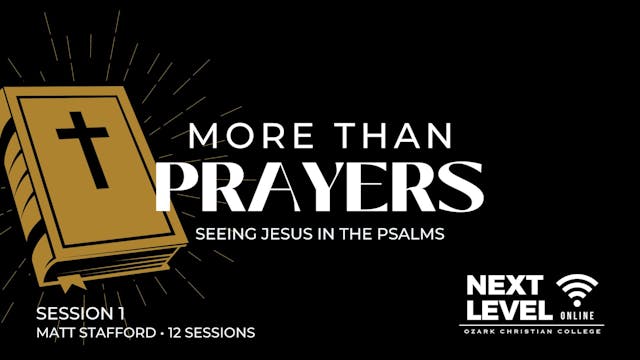An introduction to the Psalms and Hebrew Poetry (Psalm 1)


The vision of Ozark Christian College is to glorify God by evangelizing the lost and edifying Christians worldwide. The mission of Ozark Christian College is to train men and women for Christian service as a degree-granting institution of biblical higher education.
An introduction to the Psalms and Hebrew Poetry (Psalm 1)
Summary: The Book of Psalms contains the collected prayers and songs of the Jewish people written from the time of Moses to the return from their exile in Babylon. These songs and prayers reflect universal human experiences, they teach us how to pray by their example, and they ultimately point us to the answer to those prayers in Jesus Christ.
Notes:
THE STRUCTURE OF THE BOOK OF PSALMS
The Psalms are presented to us in five books, the number five corresponding to the five books of the law (Genesis to Deuteronomy). God speaks to us through the five books of the law, and we speak to him through the five books of the psalms.
Books 1 & 2 (1-72) are largely psalms of David (72:20). David experienced both victories (military, leadership, integrity, and known as a man after God’s own heart) and tragedies (the violent death of his best friend and two sons, the deaths of two infant sons, betrayal by advisors and his own son, illness, life as a fugitive, sibling rivalry, a broken marriage, failure as a parent, and sexual sin). He is a type of “everyman” that we can all identify with in many ways.
Book 3 (73-89) wrestles with God’s apparent abandonment of the nation during the Jewish exile in Babylon in 586 BC. Where was God and what about his promises? Can he be trusted?
Book 4 (90-106) answers the questions of Book 3 with a resounding “The LORD reigns”
Book 5 (107-150) expresses thanksgiving for the salvation of God in all of its aspects. It includes many festival songs used in Israel’s gathered worship.
CHARACTERISTICS OF HEBREW POETRY
Parallelism: correspondence between two or more lines of poetry. This has the effect of slowing us down and encouraging reflection, aiding with memory, and making Hebrew poetry more easily translated into other languages.
Imagery: the use of metaphor and symbolic language to promote reflection and increase understanding
Chiasm: an ABA pattern in which a sequence of ideas is presented and then repeated in reverse order, creating focus on the central idea by framing it
Discussion:
An introduction to the Psalms and Hebrew Poetry (Psalm 1)
Summary: The Book of Psalms contains the collected prayers and songs of the Jewish people written from the time of Moses to the return from their exile in Babylon. These songs and prayers reflect universal human experiences, they teach us how to pray by their example, and they ultimately point us to the answer to those prayers in Jesus Christ.
Notes:
THE STRUCTURE OF THE BOOK OF PSALMS
The Psalms are presented to us in five books, the number five corresponding to the five books of the law (Genesis to Deuteronomy). God speaks to us through the five books of the law, and we speak to him through the five books of the psalms.
Books 1 & 2 (1-72) are largely psalms of David (72:20). David experienced both victories (military, leadership, integrity, and known as a man after God’s own heart) and tragedies (the violent death of his best friend and two sons, the deaths of two infant sons, betrayal by advisors and his own son, illness, life as a fugitive, sibling rivalry, a broken marriage, failure as a parent, and sexual sin). He is a type of “everyman” that we can all identify with in many ways.
Book 3 (73-89) wrestles with God’s apparent abandonment of the nation during the Jewish exile in Babylon in 586 BC. Where was God and what about his promises? Can he be trusted?
Book 4 (90-106) answers the questions of Book 3 with a resounding “The LORD reigns”
Book 5 (107-150) expresses thanksgiving for the salvation of God in all of its aspects. It includes many festival songs used in Israel’s gathered worship.
CHARACTERISTICS OF HEBREW POETRY
Parallelism: correspondence between two or more lines of poetry. This has the effect of slowing us down and encouraging reflection, aiding with memory, and making Hebrew poetry more easily translated into other languages.
Imagery: the use of metaphor and symbolic language to promote reflection and increase understanding
Chiasm: an ABA pattern in which a sequence of ideas is presented and then repeated in reverse order, creating focus on the central idea by framing it
Discussion:

Phone: 918-994-2638 | Email: support@churchapps.org
© Live Church Solutions. All rights reserved.